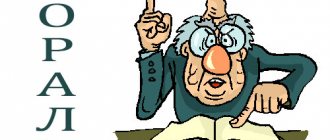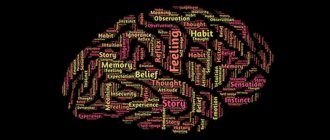Deviation is a set of deviations in personal behavior, which are based on a violation of social norms and rules. From the point of view of social science, deviations in society are a threat to security. Everyone understands this, but immoral acts and illegal actions are not uncommon today.
It is important to understand that deviation is a phenomenon that cannot be considered only as negative manifestations, because heroism or talent in a particular area is also considered a deviation from the average statistical norm. But these will be anomalies of a completely different nature.
What is deviation - concept
Deviation is a deviation from a behavioral norm. The concept of deviation is described in Efremova’s explanatory dictionary - (from Latin deviatio - deviation) deviation, change in development, condition, movement, etc. something under the influence of smb. external forces, conditions, etc. (Explanatory Dictionary of the Russian Language, edited by Efremova, 2012).
Deviation in sociology is a stable behavior of an individual, deviating from generally accepted, most widespread and established social norms, illegal actions.
The definition of deviation in social science is the motivational actions of an individual, which are fundamentally different from generally accepted values and rules of behavior in society, formed in a given culture or state.
Definition of the concept
In psychology, deviance is human behavior that disrupts the stability of interpersonal interaction. Psychologists say that deviation is the behavior of an individual that contradicts sociocultural norms, moral and ethical principles of society.
The structure of deviation includes:
- human behavior;
- value relations and moral orientations of the individual;
- social norms and rules, which are the main criterion for deviant behavior;
- evaluative attitude of others.
Sometimes the manifestation of mental illness from the outside looks like a deliberate violation of norms and rules. But deviant behavior and a medical diagnosis cannot be equated.
Theories of deviation with examples from life
There are many theories of deviations, but their essence can be reduced to 3.
| Deviation theory. | Description. | Example. |
| Biological. | Cesare Lombroso worked on the theory of deviations. He studied criminology and believed that the reason for breaking the law is the innate depravity of a person. | A person exhibits deviant behavior due to high testosterone levels, genetic predisposition, extra chromosomes, and lack of brain structures that are responsible for empathy. |
| Psychological. | This theory of deviation is supported by many psychologists, including Sigmund Freud. The essence of the theory is that deviants are not born, but become deviants due to negative life conditions. | A person’s experience of moral, physical, sexual violence, psychological trauma. |
| Social. | They represent the connection between deviant behavior and the conditions of the sociocultural environment. | Quetelet studied this theory, citing as evidence the fact that crime and cruelty are developed in disadvantaged areas. |
Signs and typical manifestations of deviation
Signs and typical manifestations of behavioral deviations from the norm are:
- Self-centeredness. The deviant strives to satisfy his needs by any means, ignoring the needs of others. At the same time, he does not accept condemnation and criticism addressed to him.
- Aggression. This form of behavior is a natural consequence of the fact that a person who violates sociocultural norms is, for one reason or another, constantly in a tense state. He believes that achieving a goal and getting what you want is possible only through the use of physical strength and assertiveness.
- Poor self-control. The deviant does not think about how others will react to his or her actions. He simply does what he wants to do at the moment. His actions are rash and therefore unpredictable. It is not possible to curb his bad temper.
- Painful reaction to criticism. The deviant puts those who criticize his work or actions on the list of his worst enemies. He is offended by comments, snaps, and is rude. He is unable to benefit from criticism.
- Unreasonable mood changes. Positive and negative emotional states replace each other in a matter of minutes. According to psychologists and psychophysiologists, this is due to exhaustion of the nervous system.
- Closedness and desire for solitude. A person with deviant behavior hides his thoughts and feelings from others. He doesn't trust anyone, so he keeps a personal distance even with his comrades.
- Psychical deviations. Even if the deviant does not have a psychiatric diagnosis, the tendency to commit illegal actions leads to irreversible changes in personal structures.
- Involvement of an individual in criminal groups. Defiant behavior of the individual and the desire to get what he wants at any cost are approved by criminals.
Signs of deviation form a pathological model of behavior, which is not only dangerous for society, but also destructive for the individual himself. If psychological and pedagogical assistance is not provided to the deviant in a timely manner, he may begin to degenerate.
Types of deviation
All deviations can be divided into two large groups - violations of generally accepted norms of social life and mental deviations .
These two large groups include different types of deviations and ways of considering them.
Social deviation
The basis of social deviation is motivation. Social deviation is the only type of deviant behavior that can be both positive and negative.
Examples of negative social deviation:
- vagabond lifestyle, lack of permanent residence;
- constantly asking for alms from others;
- trade in one's own body;
- being on the street or in public places under the influence of alcohol or drugs;
- a monastic lifestyle, in which a person renounces all earthly goods (participation in sects is also a social deviation);
- brilliant people who work for an idea (while not always looking neat, saying strange things, etc.);
- sadistic behavior, vandalism;
- lawbreakers (thieves, murderers, car thieves, etc.).
Examples of positive social deviation:
heroic deeds;
making significant scientific discoveries that completely change the life of society;
organizing rallies and struggles for equality;
geographical, historical discoveries.
Sexual deviation
It is sometimes difficult to separate sexual deviation from the norm; many sociologists and psychologists have tried to do this.
Ray Blanchard believes that normal sexual behavior is:
- oral sex;
- anal and vaginal penetration;
- masturbation, including mutual;
- kisses.
Deviation from the norm and deviant sexual behavior is considered:
- sexual interest in the products of human activity;
- desire to come into contact with persons with obvious physical disabilities;
- manifestation of sexual cruelty towards a partner (BDSM).
Gender deviation
This type of social deviation is subject to criticism and heated debate.
The essence of gender deviation is due to the fact that at birth a child is taught a certain gender model of behavior. For example, girls are dressed in light clothes, taught to preen themselves, and instilled in a love of jewelry and cosmetics. Boys are bought equipment as toys, dressed in simple and comfortable clothes, and are taught toughness in character (“be a man,” “boys don’t cry”).
These behavior patterns are subsequently reinforced. If a discrepancy occurs, it is considered a deviation and is condemned by society.
For example, they speak disapprovingly of girls who go to serve in the army or of guys who decide to wear makeup.
Communication deviations
There are a number of communicative deviations that are associated with the developmental characteristics of a particular personality:
- Autism. The phenomenon may be congenital or formed due to improper upbringing or prolonged exposure to a stressful situation. Such people strive for loneliness, they are bad at establishing contacts with society.
- Hypersociality. Hypersocial people are sensitive to loneliness; they strive to communicate with as many people as possible. Such sociability has a pathological form and differs from ordinary love to talk.
- Presence of phobias or fears. Almost all people have phobias and fears, but some of them can seriously interfere with successful social interaction. For example, the fear of blushing in public or appearing funny.
Teenage deviations
In their work, teachers and social psychologists often encounter deviant behavior of adolescents. Teenage deviations are:
- extremism, terrorism;
- violation of current legislation;
- addiction to bad habits;
- defiant appearance;
- impaired response in ordinary life situations;
- addiction to gambling;
- cruelty to animals, destruction of nature;
- severe forms of egoism, egocentrism;
- desire to minimize social contacts;
- habit of swearing and using foul language;
- ignoring the words of adults, their comments and demands;
- inability or unwillingness to control one’s own behavior;
- constant interruptions in mood, which lead to disruption of the nervous system;
- aggression, desire to damage oneself;
- the desire to solve any problems through a fight;
- attempts to die.
Teenagers can also demonstrate positive deviations:
- increased talent, genius, success in the fields of science or art;
- high level of patriotic education;
- performing significant actions for the benefit of society;
- the ability to sacrifice oneself for the sake of a common cause or the good of another person;
- a desire to help others, a heightened sense of mercy, self-sacrifice;
- high degree of hard work, sense of duty;
- unique human abilities.
Forms
Forms of deviation were identified by R. Merton. When analyzing deviation, he did not consider the act itself, but tried to establish what element of a person’s life served as the motive for this or that action. He paid close attention to the methods by which a person achieves an asocial or prosocial goal. He associated the concept of deviation with the contradiction between the needs of the individual and his capabilities to satisfy them.
When Merton was asked to name the main forms of negative deviation, he said that they could be any attempt by an individual to express himself or express his opinion. Only comfortable behavior did not fall into his definition of deviation, since it presupposes complete submission to norms and rules. Giving up individuality.
Followers of Robert Merton's concept divided deviations into negative and positive forms. Sociologists believe that both of these forms of deviation will always exist in society. After all, if there are rules established by someone, there will definitely be those who will break them. Deviations are most often observed during periods of crisis, when legislative reforms take place and strict sanctions and restrictions are introduced. This leads to increased dissatisfaction among the population with their income and living conditions. A natural consequence of personal dissatisfaction is cynicism, egocentrism, corruption, and attempts to satisfy one’s own interests by illegal means.
From a medical point of view, deviation is any behavioral deviation from the norm. V.D. Mendelevich identified such forms of this phenomenon as:
- Criminal form (delinquent behavior). Psychiatrists believe that this type of deviant behavior is based on personal dissatisfaction with one’s own life and desperate attempts to defend one’s interests by any means.
- Psychopathy. Organic pathology distorts human perception. The patient develops psychosis, obsessions, and phobias. The individual sees an enemy in everyone he meets. In most cases, such patients are recognized as insane by the conclusion of a forensic medical examination.
- Addiction. A person, using chemical or non-chemical methods, tries to escape from a reality that does not suit him.
Forms of deviation
Forms of deviation are divided into positive, negative and neutral .
Negatively colored deviation is various types of addiction, violations of the law, and cruel behavior.
Positive deviation can include donating benefits for the development of society, performing any significant work for free.
Socially neutral deviations include reluctance to start a family, excessive shyness or isolation.
Examples of deviations
I will give examples of negative, neutral and positive deviations:
- The child was born into a prosperous full family. The parenting style was overprotective. Having reached adolescence, the child became uncontrollable: he began to blackmail his parents and insult his mother. Parents believed that adolescence is difficult for all children; they need to be patient. They did not take active measures to solve the problem; they reduced control and custody of their son. As a result, the parents did not notice how the boy got involved with bad company, where he became addicted to drugs.
- The girl has been shy since childhood. It is difficult for her to talk to a stranger, to make a request to someone. Mom believes that shyness is synonymous with modesty, so she makes no attempt to eradicate this character trait of her daughter. The girl has few friends; in class she is considered withdrawn because she does not greet her classmates and refuses to play group games during breaks. On the part of the teachers, there are no complaints against the girl regarding her studies, no sanctions can be applied to her, her shyness does not harm others, but is at the same time a form of neutral deviation.
- For many years, an employee of the research institute has been developing his own methodology for teaching preschool children to read. After defending his doctoral dissertation, he opened a linguistic center and began working with children according to his own program. After a few months, 4-5 year old children learned to read. The innovative activity of a scientist in this case is an example of positive deviation.
Types of deviation and examples
In modern science, Merton identified deviation, which can be divided into 5 types.
| Type of deviant behavior. | Description. | Example. |
| Delinquent type. | Causing some harm to others and society in order to have fun or draw attention to oneself. Sometimes these are illegal actions, frivolous acts (they can be committed at the suggestion of other people). Often this behavior is demonstrated by people with unresolved internal conflicts. | Rock musicians who cause riots or engage in vandalism. |
| Addictive type. | A person wants to change his condition artificially in order to be able to escape reality (taking psychoactive substances, drugs, alcoholic beverages). A person in real life cannot find activities and emotions that would satisfy him. | Many creative people had addictive behavior: Lewis Carroll, Honore de Balzac, Edith Piaf, Mikhail Bulgakov, William Faulkner, Truman Capote. |
| Pathocharacterological type. | A person’s behavior is caused by changes in his character due to improper upbringing or lack thereof. This is often characterized by personality disorders or character accentuations. | A person with a schizoid personality type stops communicating with friends, parents and colleagues without explanation. |
| Psychopathological type. | This is a manifestation of mental disorders and diseases. A person suffers from hallucinations, thinking disorders, and commits actions incomprehensible to a healthy person. | The main character of the movie "Split" or the book "The Many Minds of Billy Milligan." |
| Based on hyperpowers. | A person exists in parallel in two worlds, his own and the real. A person perceives the real world as not too significant; he tries not to interact with it. Usually such people are eccentric and do not want to enter into close contacts or close relationships with them. | Alexander Suvorov woke up every night at exactly 2 o’clock to douse himself with cold water and crow like a cock. He could meet guests in only his underwear. |
There is another classification of types of deviant behavior.
| Type of deviant behavior. | Characteristic. | Example. |
| Innovator. | People want to succeed in society and be full members of it, but they prefer to follow their own path of development. | Creators of financial pyramids, businessmen, cooperators. |
| Ritualists. | Such people often bring social principles to the point of absurdity and try to change the existing system. | Citizens who regularly organize rallies and strikes. |
| Retreatists. | Escape from existing reality, the desire to escape from reality, rejection of generally accepted goals and ways of their implementation. | People without a fixed place of residence, drug addicts, alcoholics, tramps. |
| Revolutionaries. | People who are not satisfied with the existing social system, they want to replace it with a new one. | There are many revolutionaries among historical figures: Vladimir Lenin, Leon Trotsky, Karl Marx, Fidel Castro and others. |
What do you think about types of deviant behavior? Do you know any interesting examples? Be sure to share them in the comments, and we’ll discuss them together.
Types
It is believed that deviations from the norm in the form of deviation can be classified into the following types:
- positive deviations from the average norm;
- negative deviations associated with mental disorders;
- illegal and criminal acts;
- cultural deviations;
- aggressive actions;
- antisocial behavior;
- negative non-criminal actions (suicidal attempts, vagrancy, alcoholism, drug addiction).
All deviations are divided into 2 types: primary and secondary. Primary deviation is a type of deviant behavior that is not punished in any way by authorized bodies. Secondary deviation is an irreversible change in the personal sphere that occurs as a result of the systematic repetition of certain actions of a destructive nature.
Depending on the number of participants in antisocial actions, deviations can be group or individual.
Clayburgh suggests dividing all deviations in society into 3 types:
- negative (crime, substance use);
- neutral deviations (vagrancy, begging);
- positive (self-sacrifice).
E. Zmanovskaya believed that deviation is a social phenomenon that needs to be talked about in simple terms from the point of view of the negative consequences of an individual’s actions for himself or for society. She identified the following types of this social phenomenon:
- self-destructive deviant behavior (examples of such deviation are suicide, victimization, unjustified risk);
- asocial disregard for the norms and rules of public life (protest against legislation causes universal condemnation and is punishable by sanctions);
- antisocial actions that threaten the life and health of citizens
According to another classification, the following types of deviation are distinguished:
- Innovation – this type involves the use of prohibited actions to achieve a goal. In a negative context, this type of deviant behavior is characteristic of criminals and blackmailers. In the positive version, such deviant behavior is used by scientists.
- Retreatism is a kind of escape from reality. This way of existence is used by people with alcohol, gaming or drug addiction.
- Ritualism is the following of certain stereotypes that contradict the true purpose of the activity.
- Riot is an active form of protest against established norms and rules. An individual with this behavioral stereotype tries to protect his interests and put forward his ideas with the help of aggressive actions.
N. Maysak based the analysis of behavioral anomalies on two parameters: the direction of the deviant’s actions and the public’s attitude towards his actions. Depending on the direction of an individual’s actions, his behavioral reactions can be:
- constructive (creative self-expression);
- autodestructive (the individual commits actions that lead to his degradation or even death);
- externally destructive (can be expressed in the form of conflict behavior, verbal insults, illegal actions towards others).
From the perspective of society’s attitude towards deviant manifestations, all deviant behavior can be divided into the following types:
- prosocial (finds approval from most people);
- neutral (do not threaten the life and health of others, but at the same time the attitude towards them is ambiguous);
- social (crimes).
In the modern world, a separate type of deviant behavior is legitimate deviation, which includes various youth subcultures.
Signs of deviant behavior
In modern society, a number of rules and norms of behavior have been adopted. Violations are signs of deviation, deviant behavior:
- Aggressiveness, too tough temperament.
- An increased form of egocentrism.
- Inability to adequately perceive criticism and respond to it.
- Changes in mood for no apparent reason.
- Inability to independently control one’s speech and actions.
- Inability to take care of yourself.
- Increased isolation, desire to constantly be alone.
- Mental or psychosomatic system disorders.
- Communication with criminal personalities, a person’s connection with the criminal world.
- A person's desire to aggressively oppose the opinions of the majority of members of society.
Reminder about deviation
How to recognize a deviant
To better understand what deviant behavior is, you need to familiarize yourself with its manifestations or symptoms, which will tell you that this is a deviant. Even if you don’t know a person well, you just met him recently, deviations will be visible even in small things.
For example, with delinquent behavior, the individual has little idea of what laws, norms and rules are. In a comic form, he can steal chewing gum at the checkout of a hypermarket, get angry at a person who accidentally stepped on his foot, and verbally demonstrate disagreement and rebellion.
Addictive behavior is often accompanied by delinquent behavior, but can also exist independently. Such people are very vulnerable, do not tolerate loneliness well and are easily influenced. In this case, an example of deviant behavior is street groups of teenagers who use drugs and engage in robbery.
Signs of psychopathological manifestations are delusional thoughts, hallucinations, idefix, illusory perception of reality. And the destructive form of deviations is manifested by various types of aggression, directed both inward and outward.
All manifestations can be identified in a separate list:
- problem in adaptation , frequent conflicts, belonging to “bad” companies”;
- scattered attention , leaving things halfway, lack of responsibility;
- infantilism, untidiness in clothing and household activities;
- mental disorders in the form of phobias, anxieties and other neurotic manifestations;
- Typical manifestations of deviant behavior are also low self-esteem and lack of self-confidence;
- poor health, pain, psychosomatic symptoms, sleep problems;
- isolating oneself from society, frequently leaving home in order to be alone ;
- impulsive behavior, stubbornness, negativism, aggression;
- atypical inclinations and interests (for example, passion for extreme sports).
Causes of deviation
Psychologists identify quite a few reasons for the emergence of deviation:
- genetic predisposition to deviant behavior;
- adolescence (the individual is formed, often through deviant behavior he learns the boundaries of what is permitted in society);
- low level of intellectual development of the individual;
- certain character traits (tendency to rebellion, aggression, opposition);
- unfavorable financial situation in the family or region of residence;
- pronounced social inequality;
- unstable political situation in the country;
- raising a child in disadvantaged conditions;
- serious mistakes in education;
- reluctance of parents to work on the moral education of the child;
- child copying incorrect patterns of behavior;
- the inability of the individual to successfully socialize;
- high levels of stress;
- disorders of the brain or central nervous system;
- psychosomatic problems, disorders;
- difficulties in choosing the only correct model of behavior (parents say one thing, friends say another, TV says something else);
- inability to realize one’s interests and needs;
- confidence in one’s own impunity, manifestation of permissiveness;
- the habit of shifting responsibility for one’s life to other people;
- the desire to become famous, but the inability to achieve recognition in the field of art, science, sports, etc.;
- desire to gain approval from the company;
- the desire to look cool and mature in the eyes of others;
- destructive desire to change the world.
We invite you to watch a video lecture on the influence of the Internet on deviant behavior.
Prevention
Early age-related prevention of deviant behavior will help to effectively increase personal control over negative manifestations.
It is necessary to clearly understand that children already have signs indicating the onset of deviation:
- manifestations of outbursts of anger that are unusual for the child’s age (frequent and poorly controlled);
- using intentional behavior to annoy an adult;
- active refusals to comply with the demands of adults, violation of the rules established by them;
- frequent confrontation with adults in the form of arguments;
- manifestation of anger and vindictiveness;
- the child often becomes the instigator of a fight;
- deliberate destruction of someone else's property (objects);
- causing harm to other people using dangerous objects (weapons).
A number of preventive measures implemented at all levels of society (national, regulatory, medical, sanitary, pedagogical, socio-psychological) have a positive effect on overcoming the prevalence of deviant behavior:
- Formation of a favorable social environment. With the help of social factors, an individual’s undesirable behavior with possible deviation is influenced - a negative background is created regarding any manifestations of deviant behavior.
- Information factors. Specially organized work to provide maximum information about deviations in order to activate the cognitive processes of each individual (conversations, lectures, creation of videos, blogs, etc.).
- Social skills training. It is carried out with the aim of improving adaptability to society: social deviation is prevented through training work to build resistance to abnormal social influence on the individual, increase self-confidence, and develop self-realization skills.
- Initiation of activities opposite to deviant behavior. Such forms of activity can be:
- testing oneself “for strength” (risky sports, mountain climbing),
- learning new things (travel, mastering complex professions),
- confidential communication (helping those who have “stumbled”),
- creation.
- Activation of personal resources. Personal development, starting from childhood and adolescence: involvement in sports, personal growth groups, self-actualization and self-expression. An individual learns to be himself, to be able to defend his opinions and principles within the framework of generally accepted moral norms.
Only with the adequate formation of a person as a personality, an understanding of deviant behavior as an unacceptable and unacceptable form of interaction between the individual and society is created in his consciousness.
Video:
Stages of formation
The main stages and causes of deviant behavior are laid down in adolescence. A person gets to know himself, asserts himself, strives to stand out from other people.
At the first stage, a person demonstrates deviant behavior that is not approved in a particular society (plays pranks in class, talks loudly, hooligans on the street). Usually behavior is corrected by educators, teachers or parents. If measures were not taken at the first stage, then over time the violations may become more significant.
At the second stage, the teenager commits clearly condemnable deviant behavior (swears, fights, mocks classmates). Disciplinary measures must be taken against such a child.
At the third stage, deviant behavior takes root, the person regularly demonstrates deviations in his words and actions. His behavior can be characterized as morally negative (he is regularly rude to teachers, refuses to do homework, disappears on the street until late). Such a teenager needs systematic correctional work.
At the fourth stage, the individual’s behavior can be characterized as illegal, with regular relapses (vandalism, hooliganism, petty theft). Specially trained people (social educator, law enforcement officers, psychologist) should work with such minors.
The fifth stage is the criminal behavior of the individual. Typically, work with such adolescents is carried out in special closed correctional institutions.
Features of deviation
Human actions are included in social systems and relationships (street, family, work, team, and so on) with general normative regulation. Therefore, deviant behavior is behavior that disrupts the stability of social interaction processes. Stability (equilibrium) of social interaction involves the integration of the actions of many, which is disrupted by the deviant behavior of one or more people. With deviant behavior, a person usually focuses on the situation, which includes other people and expectations and general norms. Deviant behavior is caused both by dissatisfaction with others and by the norms of relationships.
For example, consider the social connection between a student and his parents during his studies at a university. His parents expect him to do well in his studies, which is difficult to combine with the roles of worker, athlete, lover, and so on. The student begins to study unsatisfactorily, that is, deviantly. In order to overcome such deviance, there are several possibilities. First of all, it is possible to change one’s own needs, which will affect the assessment of other people and norms of regulation. Thus, a student may give up motivation for excellent studies and limit himself to satisfactory results. Then you can change the object of need and thereby soften the tension in the social connection. For example, he can convince parents that his job alleviates the family's burden of college expenses. And finally, a student can leave home, stop focusing on his own parents and start focusing on his girlfriends and friends.
Conformism and deviation are two opposite types of behavior, one of which is oriented only towards the actor, and the other - towards the society in which he lives. Between deviant and conformal motivations for people’s actions lies indifferent. It is distinguished by the absence of both alienated and conformal orientation towards the situation and objects, which in this case turn into neutral.
Deviation includes three elements: 1) a person with values (orientation towards others) and norms (legal, moral, political); 2) assessing the organization, person, group; 3) human behavior. The criterion for deviant behavior is legal and moral norms. They differ in different types of societies, so behavior that is deviant in one society will not be so in another.
For example, in a bourgeois society that focuses on personal success, actions such as the exploits of Alexander Matrosov or Pavka Korchagin are deviant. And in Soviet society, which is oriented towards the interests of the state, they were considered officially heroic. The contradiction between the focus on the individual and the focus on society is characteristic of the entire history of mankind; it has found its expression in two opposing types of personalities: individualist and collectivist.
Prevention of deviant behavior
To create behavioral stability in children and adolescents and avoid deviations, it is worth:
- Develop an interest in the world around you (this needs to be done in the family and educational institutions).
- Introduce the child to the rules and norms of behavior in various life situations, conduct play or training sessions.
- Help in developing adequate self-esteem.
- Develop communication skills with different categories of people, allow you to practice.
- Work on the family microclimate and improve parent-child relationships.
Raising children with deviant behavior
Deviant behavior observed in children creates a lot of reasons for concern. Parents are lost in such situations, they do not want to believe that their child is behaving this way, they do not know how to behave correctly so as not to aggravate the situation even further.
Raising children with deviant behavior should be aimed at forming a holistic picture of the world. Such children need to be made aware of what the other person is experiencing, and given the opportunity to feel themselves in the shoes of the weak and insulted. It is not at all necessary to humiliate him; this will only lead to the opposite result. Deviant behavior requires increased attention. It is necessary to appeal to his feelings, ask appropriate questions, force him to reason and think about his actions.
Thus, deviant behavior in children needs prompt correction. Parents should not let the situation take its course, otherwise the personality will be destroyed and broken.
Correction of deviant behavior
Negative deviations need to be corrected in childhood and adolescence.
Help with adaptation
Help the deviant adapt, do not set initially impossible tasks for him, and be more lenient towards him.
For example, a child is used to solving any issue through a fight. You should not expect that a child with deviant behavior will stop fighting immediately after the conversation. It is important to celebrate any achievements of the child and not devalue them (clenched his fists, but did not hit the interlocutor; called him an insult, but did not fight; raised his voice, but resolved the issue without the participation of his fists).
Team involvement
Involve the deviant in collective activities, give the opportunity to realize their creative abilities.
For example, a teenager in chemistry lessons constantly misbehaves and interferes with others. You can give a deviant student the task of studying terms and preparing a series of experiments, and demonstrating them to the whole class in the next lesson. A fighter in a physical education lesson can demonstrate hand-to-hand combat techniques. An overly active student can be given the opportunity to perform a dance at a school concert.
Help achieve success
Organize situations in which the child can achieve success (it is worth developing incentive measures for success).
For example, a teacher knows that a particular student exhibits deviant behavior, but loves to read fantasy books. It is worth giving the deviant the opportunity in class to talk about his favorite author or prepare a message about his favorite work. You can reward your efforts with a good grade or applause.
Character traits
Positive deviant behavior is often associated with a person's strong passion for a particular area.
It is common to have a desire to prove your point of view to the bitter end - what we call genius or giftedness.
Example
People. whom we call geniuses, prodigies, extraordinary personalities, have unsurpassed abilities in some field of science or art and are very passionate about it. Their psyche is aimed at solving problems classified as “high”. For example, creating new devices or pieces of music. Outwardly, it looks like an obsession with what you love. However, the psyche of such people is structured in a special way. They exist simultaneously in two worlds, and the inner one is more important for them, and the main one for everyone else, the outer one, is in the background, insignificant. Therefore, such people cannot solve tasks that are simple in the opinion of the majority or ignore the necessary, in the general opinion, needs.
Example
Positive deviants can be not only people with special abilities, but also those with an interest focused on one area. Monks also put the outside world in second place, are reluctant to make contact, and live separately. They don't bring negativity into the world. On the contrary, they often develop strong empathy and help those whom ordinary people might ignore - they work with the homeless, go on missions to places of mass infection with dangerous diseases, etc.
Such typical manifestations of the behavior of geniuses in everyday life characterize positive deviation.
Refusal to start a family
People with deviant behavior come to this decision easily. The reason is still the same: the inner world is more important for them, they try to get involved with the outer world as little as possible
Therefore, they cannot establish long-term relationships with people, they are not able to pay attention to something or someone else. They tend to focus exclusively on their chosen area
For such people, the question of choosing between family and life’s work is not worth it at all.
This is important to consider for people who want to connect their lives and start a family with such a person. His spouse will have to bear the entire burden of household chores, raising children, and at the same time put up with the fact that the main focus of the other half will never be directed at him/her
Few agree to take on such a burden. That's why geniuses are often lonely. But this does not bother them as much as people with normal deviation.
Monks deliberately abandon family for the same reasons: it is not as important to them as the work to which they dedicated their lives and the world in which they believe
From everyday comfort
It is also easy for such people to give up some of the household amenities that most people consider necessary.
Geniuses may not notice that they haven't eaten or washed in 3 days or that their nails and hair are not in order.
Monks live in very simple conditions, devote little time to sleep and rest, eat poorly, dress simply and monotonously, and may not maintain a sufficiently warm temperature in the room, deliberately depriving themselves of these primary needs for an ordinary person.
Both of them often refuse recognition of their achievements, prizes, titles, money, fame and fame
This is external, so it doesn’t matter to them either
Low practicality in everyday matters
Geniuses are first-class specialists in their chosen field. But they may not know how to use household appliances or how to buy groceries in a store. This is very typical of positive deviants.
Monks, those who are deviants, often also do not know how to do simple things: use a mobile phone or computer, choose clothes, cook. Because in their ordinary life they do not do this.
Forms of deviant actions
The classification of deviant action was invented by sociologist Robert Merton. He proposed a systematization, based on the contradictions of goals, of all potential methods for achieving them. Each person independently makes a decision on the choice of suitable resources necessary to achieve goals acceptable in terms of social standards (success, popularity). But not every resource is valid. If there are certain disagreements in the individual’s zeal and the options he has chosen to achieve the expected result, such an action is considered deviant. But modern society provides people with conditions that do not allow them to achieve success in an honest, decent way.
Types of deviation:
- Innovation. Consistency with social norms with the potential for the use of prohibited but effective methods of achieving goals (scientists, criminals, blackmailers).
- Ritualism. Refusal of intended goals due to the impossibility of achieving them without using methods that do not contradict those permitted in society (politics).
- Retreatism. Avoidance of reality, disagreement with socially established norms, rejection of legitimate norms (alcoholics, homeless people).
- Riot. Disagreement with the goals and methods of achieving them established by society, replacement of traditional laws with the newest ones (revolutionaries).
According to R. Merton's theory, the only option for non-deviant action is conformal behavior. A person expresses agreement with the goals defined in the public sphere and selects the right ways to achieve them. Deviation does not imply only a negative approach of the individual to the behavioral laws established in society. The goal of both the careerist and the attacker is the same, approved by the environment - welfare. But at the same time, everyone chooses their own method of achieving it.
Social control as a mechanism for regulating deviations
Social control is a set of formal and informal measures aimed at preventing deviant behavior of an individual. This is a set of some means by which society or its individual group guarantees the normal behavior of its members.
Note 2
Sanctions of society or groups of people can be formally positive and negative. Positive measures include measures that stimulate the individual to behave positively.
Such measures include the assignment of various titles, awards, bonuses, and career advancement. Formally, negative measures can be considered the imposition of fines, dismissal from work, arrest, and others. Sanctions can also be informal: public reward (praise), punishment (disapproval of the team, threat). There is also such a phenomenon as a revaluation of existing norms, that is, actions that were previously considered deviant become acceptable for society.
Lecture on the topic “Deviation”
LECTURE 13. DEVIATIONS AS A SOCIAL-EDUCATIONAL PROBLEM
Prerequisites for deviation in adolescence. Types of deviations. Causes of deviant behavior in adolescents. Deviation concepts.
Prerequisites for deviation in adolescence
The transition period, like a litmus test, reveals all the vices of society. Adolescence is the most difficult and challenging of all childhood ages. It is also called adolescence, because during this period there is a peculiar transition from childhood to adulthood, from immaturity to maturity, which permeates all aspects of the development of a teenager: anatomical and physiological structure, intellectual, moral development, as well as various types of his activities.
During adolescence, the living conditions and activities of a teenager seriously change, which, in turn, leads to a restructuring of the psyche and the emergence of new forms of interaction between peers. The teenager’s social status, position, position in the team changes, and adults begin to face more serious demands on him.
Let us recall some information from anatomy and physiology, psychology and pedagogy that characterize the personality of a teenager. The anatomical and physiological characteristics of a teenager are characterized by the unevenness of his physical development, improvement of the muscular system, and the process of skeletal ossification. A teenager is characterized by a discrepancy in the development of the cardiovascular system, when the heart increases in volume, as a result of which it begins to work more powerfully, and the diameter of the blood vessels lags behind in development, which leads to some temporary circulatory disorders, etc. In adolescents, instability of the nervous system is pronounced system, which is not always able to withstand strong or prolonged stimuli, which causes a state of extreme excitement or inhibition, leads to hot temper, apathy, etc. Active puberty of a teenager occurs with a noticeable lag in the social development of the teenager, which entails socio-psychological problems of sex education.
During adolescence, a child develops a need to know himself. The answer to the question “Who am I?” often torments a teenager. He shows interest in himself, he forms his own views and judgments; own assessments of certain events and facts appear; he tries to evaluate his capabilities and actions, comparing himself with his peers and their actions.
At this age, the teenager experiences a temporary psychological distance from family and school; their importance in the development of the teenager’s personality decreases, while the influence of peers increases. Often he is faced with a choice between an official team and an informal communication group. The teenager gives preference to the environment and group in which he feels comfortable and where he is treated with respect. This could be a sports section, or a technical club, but it could also be the basement of a house where teenagers gather, socialize, smoke, drink, etc.
As a rule, at this age teenagers have problems with adults, in particular with their parents. Parents continue to look at their child as if he were small, and he is trying to break out of this care. Therefore, relationships with adults are usually characterized by increased conflict, criticality towards the opinions of adults increases, but at the same time the opinions of peers become more significant. The nature of relationships with elders changes: from a position of subordination, the teenager tries to move to a position of equality. At the same time, the nature of relationships with peers also changes, the need for communication for the purpose of self-affirmation appears, which in unfavorable conditions can lead to various forms of deviant behavior; increased interest in issues of a person’s intimate life, which can lead to asocial violations of a teenager’s sexual life.
The teenager develops a sense of adulthood, which manifests itself through the desire for independence and independence, protest against the desire of adults to “teach” him. A teenager at this age often chooses an idol for himself (a film hero, a strong adult, a TV show hero, an outstanding athlete, etc.), whom he tries to imitate: his appearance, demeanor. Appearance is very important for a teenager. An unusual hairstyle, an earring, or even two or three in the ears, torn jeans, bright cosmetics and other attributes give a teenager the opportunity to separate himself from others and establish himself in a group of children.
All this happens against the background of changes in the emotional-volitional sphere. The teenager displays an emotionally expressed desire to understand the surrounding reality, a desire to communicate with peers, and a need for friendship based on common interests and hobbies. A teenager develops the skills of self-control, self-government of his thoughts and actions, and develops perseverance, perseverance, endurance, patience, endurance and other volitional qualities.
The interests of a teenager change significantly compared to a younger child. Along with curiosity and the desire for creative activity, he is characterized by scattered and unstable interests.
Thus, we can highlight the characteristic features of adolescence: emotional immaturity, insufficiently developed ability to control one’s own behavior, balance desires and opportunities in meeting one’s needs, increased suggestibility, the desire to assert oneself and become an adult.
A teenager is a person who is not yet mature enough and socially mature enough; he is a person who is at a special stage in the formation of his most important traits and qualities. This stage is borderline between childhood and adulthood. The personality is not yet developed enough to be considered an adult, and at the same time so developed that it is able to consciously enter into relationships with others and follow the requirements of social norms and rules in its actions and actions.
A teenager is able to make thoughtful decisions, perform reasonable actions and bear moral and legal responsibility for them. It should be especially emphasized that a teenager is a person who has entered a period of legal responsibility for his actions and actions. And although the law, taking into account the peculiarities of the socio-psychological development of minors, establishes limited liability for them, older adolescence and youth can be considered as characterized by personal responsibility.
Types of deviations
Teenagers whose behavior deviates from socially accepted rules and norms of behavior are called difficult or difficult to educate. Difficulty in education is understood as resistance to pedagogical influences, which can be due to a wide variety of reasons related to the assimilation of certain social programs, knowledge, skills, requirements and norms in the process of targeted training and education.
The difficulty of raising a teenager, his failure to comply with the norms and rules established in society, is considered in science through a phenomenon called deviation. Deviation (deviation) is one of the aspects of the phenomenon of variability, which is inherent both to a person and to those around him to the world. Variability in the social sphere is always associated with activity and is expressed in human behavior, which represents his interaction with the environment, mediated by the external and internal activity of the teenager. As mentioned earlier, behavior can be normal and deviant.
Normal behavior of a teenager involves his interaction with the microsociety, which adequately meets the needs and possibilities of his development and socialization. If the child’s environment is able to respond promptly and adequately to certain characteristics of the teenager, then his behavior will always (or almost always) be normal.
Hence, deviant behavior can be characterized as the child’s interaction with the microsociety, which disrupts his development and socialization due to the lack of adequate consideration by the environment of the characteristics of his individuality, manifested in behavioral opposition to established moral and legal social norms.
It is obvious that deviant behavior is one of the manifestations of social maladjustment. Speaking about child and adolescent maladjustment, it is necessary to clarify the categories of children who are susceptible to this process:
- children of school age who do not attend school (in our country there are about 7% of them, i.e. approximately 1.5 million);
— orphans, the total number of which exceeded 500,000;
— social orphans; the reality is that due to the limited space in orphanages, children wait for months to be placed in an orphanage, living with parents deprived of parental rights, not having normal food, clothing, and being subjected to physical, mental, and sexual violence;
- teenagers who use drugs and toxic substances;
- teenagers with sexually promiscuous behavior;
- teenagers who have committed illegal acts; According to official data, their number among children and adolescents is growing twice as fast as among adults.
Deviations include deviant, delinquent and criminal behavior. Deviant behavior is one of the types of deviant behavior associated with a violation of age-appropriate social norms and rules of behavior characteristic of microsocial relationships (family, school) and small age-sex social groups. That is, this type of behavior can be called anti-disciplinary. Typical manifestations of deviant behavior are situationally determined children's and adolescent behavioral reactions, such as: demonstration, aggression, challenge, unauthorized and systematic deviation from school or work; systematic leaving home and vagrancy, drunkenness and alcoholism in children and adolescents; early drug addiction and associated antisocial actions; antisocial acts of a sexual nature; suicide attempts.
Delinquent behavior, in contrast to deviant behavior, is characterized as repeated antisocial offenses of children and adolescents, which develop into a certain stable stereotype of actions that violate legal norms, but do not entail criminal liability due to their limited social danger or the child not reaching the age at which criminal charges begin. responsibility.
The following types of delinquent behavior are distinguished:
- aggressive and violent behavior, including insults, beatings, arson, sadistic actions, mainly directed against a person’s personality;
— mercenary behavior, including petty theft, extortion, vehicle theft and other property attacks related to the desire to obtain materials for profit;
- distribution and sale of drugs.
Delinquent behavior is expressed not only in the external behavioral side, but also in the internal, personal side, when a teenager experiences a deformation of value orientations leading to a weakening of the control of the internal regulation system. Criminal behavior is defined as an unlawful act, which, upon reaching the age of criminal responsibility, serves as the basis for initiating a criminal case and is qualified under certain articles of the criminal code. Criminal behavior is usually preceded by various forms of deviant and delinquent behavior.
Negative forms of deviation are a social pathology: drunkenness and alcoholism, substance abuse and drug addiction, prostitution, suicide, delinquency and crime. They disorganize the system, undermine its foundations and cause significant damage, first of all, to the personality of the teenager himself.
The need to regulate people's behavior will always remain relevant, since there is an insoluble contradiction between human needs and the possibilities of satisfying them. The desire to satisfy material or spiritual needs is the internal motive that encourages people with insufficiently developed social orientation to actions and actions that do not correspond to generally accepted norms of behavior. Also, factors of deviant behavior can be the psychological insensitivity of an individual to the social norms established by society or the genetic predetermination of deviation.
Depending on the type of norm violated, deviant behavior is classified according to the following characteristics:
— types of crime (criminal, administrative) and immoral acts (drunkenness, prostitution);
— the level or scale of deviation, when it is customary to talk about individual or mass deviation;
- the internal structure of deviation, when deviation is associated with belonging to a particular social group, gender and age characteristics;
- orientation of deviation towards the external environment (family quarrels, violent crimes, etc.) or towards oneself (suicide, alcoholism, etc.).
Causes of deviant behavior in adolescents
Deviant behavior has a complex nature, caused by a wide variety of factors that are in complex interaction and mutual influence. We have already considered that human development is determined by the interaction of many factors: heredity, environment, upbringing, and a person’s own practical activities. It is possible to identify the main factors that determine the deviant behavior of minors.
1. Biological factors are expressed in the existence of unfavorable physiological or anatomical characteristics of the child’s body, which complicate his social adaptation. Moreover, here we are talking, of course, not about special genes that fatally determine deviant behavior, but only about those factors that, along with socio-pedagogical correction, also require medical correction. These include:
- genetic, which are inherited. These may be mental development disorders, hearing and vision defects, physical defects, and damage to the nervous system. Children, as a rule, acquire these lesions during the mother’s pregnancy due to poor and unhealthy nutrition, her consumption of alcoholic beverages, and smoking; diseases of the mother (physical and mental injuries during pregnancy, chronic and somatic infectious diseases, traumatic brain and mental injuries, sexually transmitted diseases); the influence of hereditary diseases, and especially heredity burdened by alcoholism;
- psychophysiological, associated with the influence on the human body of psychophysiological stress, conflict situations, the chemical composition of the environment, new types of energy, leading to various somatic, allergic, toxic diseases;
- physiological, including speech defects, external unattractiveness, shortcomings of a person’s constitutional and somatic make-up, which in most cases cause a negative attitude from others, which leads to a distortion of the child’s system of interpersonal relationships among peers and the team.
2. Psychological factors, which include the presence of psychopathology in the child or accentuation (excessive strengthening) of individual character traits. These deviations are expressed in neuropsychic diseases, psychopathy, neurasthenia, borderline states, which increase the excitability of the nervous system and cause inadequate reactions of the teenager. Children with pronounced psychopathy, which is a deviation from the norms of human mental health, need the help of psychiatrists.
Children with accentuated character traits, which is an extreme variant of the mental norm, are extremely vulnerable to various psychological influences and, as a rule, need social and medical rehabilitation along with educational measures.
At each period of a child’s development, certain mental qualities, personality traits and character are formed. A teenager experiences two processes of mental development: either alienation from the social environment where he lives, or inclusion. If in a family a child feels a lack of parental affection, love, attention, then the defense mechanism in this case will be alienation. Manifestations of such alienation can be: neurotic reactions, impaired communication with others, emotional instability and coldness, increased vulnerability caused by severe or borderline mental illness, retardation or delayed mental development, and various mental pathologies.
Characterological teenage reactions, such as refusal, protest, grouping, are, as a rule, a consequence of emotionally dependent, disharmonious family relationships.
If a teenager’s system of moral values is not formed, his sphere of interests begins to take on a predominantly selfish, violent, parasitic or consumer orientation. Such teenagers are characterized by infantilism, primitiveness in judgment, and a predominance of entertainment interests. The egocentric position of a teenager with a demonstration of disdain for existing norms and the rights of another person leads to “negative leadership”, the imposition of a system of “enslavement” on physically weaker peers, bravado of criminal behavior, justification of one’s actions by external circumstances, and low responsibility for one’s behavior.
3. Socio-pedagogical factors are expressed in defects in school, family or public education, which are based on gender, age and individual characteristics of the development of children, leading to deviations in the early socialization of the child during childhood with the accumulation of negative experiences; in persistent school failure of a child with a severance of connections with school (pedagogical neglect), leading to the unformation of the adolescent’s cognitive motives, interests and school skills. Such children, as a rule, are initially poorly prepared for school, have a negative attitude towards homework, and express indifference to school grades, which indicates their educational maladjustment. A student’s educational maladjustment goes through the following stages in its development:
— educational decompensation — a child’s condition characterized by difficulties in studying one or more subjects while maintaining general interest in school;
- school maladjustment - a child’s condition when, along with increasing difficulties in learning, behavioral disorders, expressed in the form of conflicts with teachers, classmates, and absences from classes, come to the fore;
- social maladaptation - a child’s condition when there is a complete loss of interest in studying, being in the school group, going into asocial companies, passion for alcoholic drinks, drugs;
— criminalization of the leisure environment. For example, the expulsion of children aged 15 from school, which is allowed by the Law “On Education”, throws children onto the street, where they cannot legally find work. Taking into account that such children, as a rule, are from low-income families, we can confidently say that their main and real means of earning a living will be of a criminal nature.
An important factor in deviations in the psychosocial development of a child is family dysfunction. It is necessary to highlight certain styles of family relationships leading to the formation of antisocial behavior of minors:
- a disharmonious style of educational and intra-family relationships, combining, on the one hand, indulgence of the child’s wishes, overprotection, and on the other, provoking the child into conflict situations; or characterized by the establishment of a double morality in the family: for the family there are some rules of behavior, for society - completely different;
- unstable, conflicting style of educational influences in single-parent families, in situations of divorce, long-term separation of children and parents;
- an antisocial style of relationships in a disorganized family with systematic use of alcohol, drugs, an immoral lifestyle, criminal behavior of parents, manifestations of unmotivated “family cruelty” and violence.
Abuse (abuse, neglect) refers to a wide range of actions that harm a child on the part of people who have custody or care for him. These actions include torture, physical, emotional, sexual violence, repeated unjustified punishment or restrictions that lead to physical harm to the child.
Children are subjected to cruel treatment in the family, on the street, at school, orphanages, hospitals and other children's institutions. Children who are subjected to such acts are deprived of the sense of security necessary for their normal development. This leads to the child realizing that he is bad, unnecessary, unloved. Any type of child abuse leads to a wide variety of consequences, but they have one thing in common - damage to the child’s health or danger to his life and social adaptation.
The type of reaction of children and adolescents to abuse depends on the age of the child, his personality traits, and social experience. Along with mental reactions (fear, sleep disturbance, appetite, etc.), various forms of behavioral disturbances are observed: increased aggressiveness, pronounced pugnacity, cruelty or lack of self-confidence, timidity, impaired communication with peers, decreased self-esteem. Children and adolescents who have been subjected to sexual violence (or assault) are also characterized by a violation of sexual behavior: a violation of gender-role identification, fear of any kind of manifestation of sexuality, etc. It seems important that the majority of children who experienced abuse (violence) by adults in childhood , tend to reproduce it, already acting in the role of a rapist and torturer.
An analysis of the family and its impact on the psychosocial development of the child shows that in a large group of children the conditions of their early socialization are violated. Some of them are in stressful situations with the risk of physical or mental violence, leading to various forms of deviation; others are involved in criminal activity with the formation of stable forms of delinquent or criminal behavior.
4. Socio-economic factors include social inequality; stratification of society into rich and poor; impoverishment of a significant mass of the population, limitation of socially acceptable ways of earning a decent income; unemployment; inflation and, as a consequence, social tension.
5. Moral and ethical factors are manifested, on the one hand, in the low moral level of modern society, the destruction of values, primarily spiritual, in the establishment of the psychology of “materialism”, the decline of morals; on the other hand, in the neutral attitude of society towards manifestations of deviant behavior. It is not surprising that the consequence of society’s indifference, for example, to the problems of childhood alcoholism or prostitution, is the child’s neglect of family, school, state, idleness, vagrancy, the formation of youth gangs, aggressive attitude towards other people, the use of alcohol, drugs, theft, fights , murders, suicide attempts.
Thus, deviant behavior appears as a normal reaction to conditions (social or microsocial) that are abnormal for a child or a group of adolescents in which they find themselves, and at the same time as a language of communication with society when other socially acceptable methods of communication have exhausted themselves or are unavailable.
Deviation concepts
The prerequisites and causes of deviant behavior discussed above formed the basis for the development of scientific concepts and theories of deviation. The main ones are: biological theory, psychological and sociological.
Proponents of the biological theory of deviation consider the deviation of behavior from the social norm accepted in society in connection with the biological make-up of the individual. In the 19th century Italian doctor C. Lombroso discovered a connection between a person’s criminal behavior and a certain physiological structure of his body. Thus, when defining the criminal type of behavior of a criminal, he identifies the following characteristic features: a protruding lower jaw, a sparse beard, and decreased sensitivity to pain.
The famous American psychologist and physician W. H. Sheldon later identified the physiological type of a person prone to deviation. In his opinion, this is the “mesomorphic type with the following epithets of the body structure: “heavy”, “muscular”, “athletic”.
In psychological and psychiatric concepts, the emphasis is on the personal factors of a person. Careful research has shown that the essence of deviation cannot be explained solely on the basis of any one psychological trait or complex. In 1950, Schuessler and Kressley tried to prove that criminals have special psychological traits that are not characteristic of law-abiding citizens, but their attempts failed. From this it was concluded that deviance probably results from a combination of psychological and social factors.
From the point of view of role theories, a child in the process of socialization must master the roles that are most significant for him, but if this process is disrupted, a compensatory mechanism may begin to work. The child will still master roles, but no longer social, but antisocial, for example: thief, drug addict, hooligan, fighter, etc., which are characterized by certain attributes.
Mastering the role will occur in several stages. Initially, the child receives certain information about this role, its rights and responsibilities, learns various forms of deviant communication, ways to clarify relationships, and a mechanism for resolving controversial issues. Next comes the stage of accepting this role, when it is realized and personal meaning is invested in it.
Then comes the playing of the role chosen for oneself. It is very important here to get the approval of your comrades in order to feel comfortable in this role. It largely depends on the reaction of others whether the unlawful act will be reinforced by the attention, approval, and praise of peers, or will not receive such reinforcement and will be condemned. In this case, the likelihood of such an unlawful act occurring again will be significantly reduced. For a teenager trying alcohol or drugs for the first time, the first priority is not to know their taste or influence on a person, but the desire to feel among their own, to get rid of the feeling of isolation and anxiety.
The last stage of role acceptance is assigning the chosen role to the oboe, for example, “scapegoat”, “secret avenger”, “rude person”, etc. on the psychological level (when the child knows exactly what emotions accompany this role and how they need to be regulated) and interpersonal (when certain types of relationships are built between children playing different roles, just as actors play in the same play) levels.
An important element of social deviations is the attitude of the individual himself to the violations he has committed. For the most part, this attitude is self-justifying in nature, which manifests itself as a self-protective reaction of the body. Social psychologists have proven that adolescents with deviant behavior tend to strive for self-satisfaction of the psychological need to justify their actions and actions, no matter how dangerous they may be. Moreover, due to the progressive degradation of personality, the motivation for actions is reduced and lost, which leads to a complete loss of the human desire for recognition and success. Primary deviation (the initial violation of social norms) passes into secondary, and then to building a deviant career - the process of ascent from weak forms of deviation to strong ones, for example, from everyday drunkenness to committing a criminal offense.
Taking on the role of a deviant can lead a child to social isolation, followed by the stage of formation of a deviant personality structure, which is determined by deviant self-awareness, which does not allow (or limits) the child to master positive social roles and useful activities.
Sociological concepts try to take into account deviation the social and cultural factors that influence and determine human behavior in society. For the first time, a sociological explanation of the essence of deviation was proposed by E. Durkheim, who developed the theory of anomie (from the Greek anomos - lawless, normless, uncontrollable). By anomie he understood a state of society in which there is no clear regulation of people's behavior due to the absence of all sorts of norms and values in society (the old ones have become obsolete, and the new ones have not yet been accepted). In such conditions, indifference, alienation, and distrust of people towards each other are observed, the stability of the family institution is lost, and complete indifference to the activities of the state is expressed. Deprived of goals and meaning in life, people become susceptible to stress and anxiety, which leads to various forms of deviant behavior.
The main idea of E. Durkheim was that the stable functioning of society is based on the phenomenon of social solidarity, and any deviations from it are social disorganization, which is the cause of deviant behavior. Having collected extensive factual material, he proved that the number of suicides in different social groups is not the same: Catholics have fewer of them than Protestants. The explanation for this phenomenon was given as follows: the higher the level of cohesion and solidarity of a social group, the lower the suicide rate. City dwellers and Protestants were more divided and individualistic than villagers and Catholics, who lived in communities with highly developed collective forms of mutual aid.
R. Merton in 1938 made some changes to the theory of E. Durkheim. In his opinion, the emergence of deviation occurs as a result of a gap between the cultural goals of society and socially approved means of achieving such goals, such as, for example, not all people, due to certain socio-economic reasons, can obtain a higher education or a prestigious job, and the level of development of society requires highly qualified specialists . That part of the population that cannot obtain the required level of education begins to satisfy their educational needs, but already, for example, in a criminal environment.
Thus, the structure of individual deviant behavior consists of actions, motives and goals. The initial link of deviant behavior is a change in value orientations in various segments of the population and social groups, which is determined by the real socio-economic conditions of the functioning of society. If our society was recently dominated by such values as work for the common good, friendship, mutual assistance, family, patriotism, etc., now they have been replaced by acquisitiveness, the cult of money, a riotous lifestyle, self-centeredness, etc. Consequently, in society there are discrepancies between proclaimed values and actually existing ones; between the planned goals and the opportunities that exist for their implementation.
Distortions in the value system mostly lead to the disintegration of social institutions. For example, violations in the work of justice institutions - the court, the prosecutor's office, the penitentiary system - lead to the disintegration of the government apparatus, giving rise to immorality, lack of faith in justice, apathy and aggressiveness. A “dual morality” arises, in which conflicting norms are used by the same person or social group for different purposes and in different opposing situations. This is manifested in the activities of some government officials, politicians, businessmen, etc. Social norms dictate “do not steal,” and the state limits the ability to use legal ways to earn a living, which forces a certain part of the population to violate social norms and allow social deviations. “Shadow rule-making” arises, a kind of “morality of the underworld*. Hence the obvious contradiction between the subject’s need to get out of a conflict situation and the impossibility of doing this in a socially acceptable, legal way.
Culturological theories (Sellin, Miller, Suter-Land) believed that the cause of deviation is in conflicts between the norms of the dominant culture and the norms of the subculture that develops in a particular social group.
The theory of stigmatization (branding), of which Charles Becker was a representative, believed that deviance is a “brand” that groups with power place on the behavior of less protected groups or an individual.
Radical criminology (Turk, Quinney, Young, Taylor) defended the position that deviance is the result of opposition to the norms of capitalist society.
The newest theories of deviation place emphasis on the character of society and seek to identify the extent to which it is interested in creating and maintaining deviation, placing emphasis on the correction not of any specific person, but of the whole society.
The study of the mechanisms of social deviations shows that the factors that predetermine deviation from social norms are: the level of consciousness, morality, the development in society of a system of social regulators of human behavior and the formed attitude of society towards people who violate moral and legal norms.
Questions for self-control
1. Reveal the features of adolescence that influence the formation of deviations from accepted norms.
2. Reveal the essence of the concepts “deviant behavior”, “delinquent behavior”, “criminal behavior”.
3. Name and justify the main reasons for deviant behavior of minors.
4. Name the main ideas of biological, psychological and social theories of deviation.
Literature
1. ABC of moral education / Ed. I. A. Kairova, O. S. Bogdanova. - M., 1979.
2. Almazov B. N. Mental environmental disadaptation of minors. - Sverdlovsk, 1986.
3. Bazhenov V.G. Education of pedagogically neglected teenagers. - Kyiv, 1986.
4. Belicheva S. A Fundamentals of preventive psychology. - M., 1993.
5. Bestuzhev-Lada I. V. Risk factors. - M., 1989.
6. Levi V. L. Non-standard child. - M., 1983.
7. Zakharov A.I. How to prevent deviations in a child’s behavior. - M., 1986.
Classification of sexual deviations
Sexual deviations include:
- Porn addiction;
- Fetishism and transvestism;
- Phobias;
- Incest;
- Bestiality;
- Pedophilia and gerontophilia;
- Exhibitionism and voyeurism.
The listed types of sexual deviations have different significance, since some of them are today considered as a variant of the norm, and some as symptoms of a mental disorder. More information about sexual deviations is described in the article “Sexual perversions, or what is usually kept silent about.”
Free consultation with a sexologist
Get access











